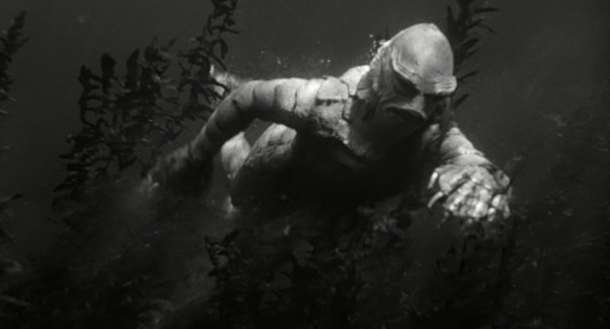
Universal Monster Classics: Creature from the Black Lagoon (1954)

Cast: Richard Carlson, Julie Adams, Richard Denning
Director: Jack Arnold
Country: USA
Genre: Adventure | Horror | Sci-fi
Official Trailer: Here
We are at the end. Here is the final entry in the Universal Monsters Classics series, for a movie released eleven years after Phantom of the Opera. I have always greatly enjoyed the technical mastery at work in Creature from the Black Lagoon, a film which benefits from being released in 1954, 23 years down the road and that much more advanced when it came to special effects. This and The Invisible Man are the best effects pictures of the series, with The Wolf Man close behind. Creature from the Black Lagoon relies greatly on a realistic look for its complex creature, a gill man who is a mixture of man and sea monster. I also see this film as a sort of transitional film between the classic horror monsters of the 30s and 40s and the science fiction, postwar films that were wildly successful in the 50s. Not that this film deals with extraterrestrials, but the look and feel of the film is brighter, more adventurous and, in a sense, more American than any of the other entries.
Creature will never stand toe to toe with the earlier Universal Horror Classics, but on its own it is a wonderfully thrilling and tense adventure picture.
Creature from the Black Lagoon begins with lofty aspirations as a voiceover discusses the creation of the universe and, ultimately, the planet Earth. We travel from this moment of life beginning, to the oceans, then to the shores where evolution becomes the focal point of the story. This is a fascinating angle for a film released in 1954, when the discussion of evolution was still somewhat taboo. But science was making advancements after World War II, and this film is a direct offshoot of these new studies. The creature itself is a mixture of man and marine animal, with two arms and legs, a body covered in gills and a mouth like a sea urchin.
 The story in the film revolves around a group of scientists, American scientists, who uncover a skeletal claw of a gill man. The claw is unearthed along the Amazon River, so the explorers decide to lead an expedition down the Amazon to see if they can find any living examples of this mysterious creature whose hand has the structure of a human hand but is webbed and scaly. The crew consists of some wonderfully familiar 50s adventurers, robust and arrogant men and an intelligent but alluring female, Kay, played by Julie Adams. Kay is a strong female personality in the film, stronger than any of the previous damsels in distress, and her dark features are a nice change of pace form the dreamy blondes of the past. OF course, it isn’t long before the expedition run into the creature, a menacing monster that stalks and kills unsuspecting members of the team.
The story in the film revolves around a group of scientists, American scientists, who uncover a skeletal claw of a gill man. The claw is unearthed along the Amazon River, so the explorers decide to lead an expedition down the Amazon to see if they can find any living examples of this mysterious creature whose hand has the structure of a human hand but is webbed and scaly. The crew consists of some wonderfully familiar 50s adventurers, robust and arrogant men and an intelligent but alluring female, Kay, played by Julie Adams. Kay is a strong female personality in the film, stronger than any of the previous damsels in distress, and her dark features are a nice change of pace form the dreamy blondes of the past. OF course, it isn’t long before the expedition run into the creature, a menacing monster that stalks and kills unsuspecting members of the team.
The underwater scenes of the creature are fantastic, even by today’s standards. This is because the creature’s suit was fluid and its flaws hidden beneath the water, but the camera work is effectively threatening as the creature reaches out for Kay’s feet in the water. When the creature surfaces and attacks the crew his effectiveness is marginalized only slightly. What we get to see when he is on land is a pair of dead, fishlike eyes and his gills contracting and expanding on the side of his head. The costume is truly iconic in the canon, and for a young child the creature was always the most thrilling to see in action.
Creature from the Black Lagoon will never stand toe to toe with the earlier Universal Horror Classics, but on its own it is a wonderfully thrilling and tense adventure picture. The canvas is expanded beyond indoor sets and castles and labs, and the river sequences give the film a sense of broad adventure when compared to the earlier films. It is also decidedly more American, with all of the main players being American and the look and feel of the film being comparable to the sci-fi matinee features of the 50s. It has been a fun ride, revisiting the Universal Horror Classics, some for the first time in twenty years.
Related Posts
![]()
Larry Taylor
![]()
Latest posts by Larry Taylor (see all)




























